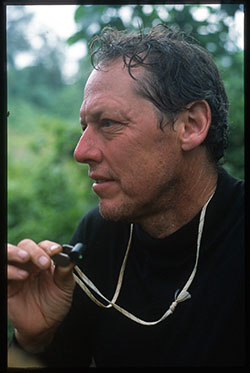
Contact Us
Institutional Communications
Bureau of Mines Building, Room 137
Laramie, WY 82071
Phone: (307) 766-2929
Email: cbaldwin@uwyo.edu
UW’s Sims Receives NSF Grant to Study Construction of Mid-Ocean Ridges
Published August 01, 2023

Ken Sims, a professor in UW’s Department of Geology and Geophysics, recently received
a $325,841 National Science Foundation grant to look at understanding the processes
and timescales of basalt petrogenesis -- the generation of magma from the mantle --
and oceanic crustal construction at slow-spreading, mid-ocean ridges. (UW Photo)
Mid-ocean ridges represent regions of the planet where volcanic activity is generating fresh oceanic crust and submarine mountain chains -- known as axial volcanic ridges -- as two tectonic plates spread apart. Seventy-five percent of Earth’s magmatic activity happens at mid-ocean ridges.
Despite the importance of mid-ocean ridges, many essential details of their construction and genesis are still unknown or poorly understood.
Ken Sims, a professor in the University of Wyoming’s Department of Geology and Geophysics, recently received a $325,841 National Science Foundation (NSF) grant to better understand the processes and timescales of basalt petrogenesis -- the generation of magma from the mantle -- and oceanic crustal construction at slow-spreading, mid-ocean ridges.
The three-year research grant is for a project titled “Collaborative Research: Understanding the Processes and Timescales of Basalt Petrogenesis and Oceanic Crustal Construction at Slow-Spreading Mid-Ocean Ridges.” The project was selected through NSF’s Ocean Science Marine Geology and Geophysics Program. The grant began July 1 and runs through June 30, 2026.
“This project aims to measure the chemical characteristics of basalts -- the dominant volcanic rock produced along mid-ocean ridges -- collected from the planet’s largest extent of mid-ocean ridge, known as the Mid-Atlantic Ridge, to understand which components of the mantle are melting and the timescales of oceanic crustal construction,” Sims says.
These volcanic and tectonic areas offer critical insight into the composition of Earth’s mantle; how it melts to create fresh oceanic crust; and the rate at which this new oceanic crust is created.
Sims, the principal investigator on the project, will work with other scientists from the U.S., U.K. and France. Cole Messa, a UW Ph.D. student in isotope geochemistry and igneous petrology, will assist Sims with the grant work. Messa, from Doylestown, Pa., already has obtained bachelor’s degrees in political science and geosciences, both from Penn State University.
Additionally, Sims will work with Rick Aster, a professor of geophysics and department head of the Department of Geosciences at Colorado State University, who secured a $37,095 NSF grant of his own for the project. Described by Sims as “a longtime collaborator and buddy,” Aster will work with Sims to interpret the crustal and mantle structure beneath the mid-ocean ridge at 45 degrees N. latitude on the Mid-Atlantic Ridge.
“We will use seismic waves that travel through the earth due to earthquakes -- sort of like a CAT scan but, instead of using X-rays, we are using sound waves,” Sims explains. “These sound waves travel at different speeds to changes in the composition and even the presence of melt.”
The NSF grant requires a public outreach project. In this case, an interactive museum exhibition titled “Earth’s Oceans: Now and in the Past” will be created at the UW Geological Museum. Of the NSF grant, $20,000 will be used for this public outreach project, which will be part of the museum’s larger plan to update and build an interactive exhibition titled “Wyoming’s Oceans,” designed to speak to and inform preschoolers to senior citizens on Wyoming’s long-lived ocean environments, Sims says.
“Although now landlocked, Wyoming has a deep geologic history of existing as an ocean floor, and we have a rich marine fossil record,” Sims says. “For this proposal’s broader impact, we propose to augment the museum’s current exhibit by adding a component on the discovery and research of ocean floors today.”
The proposed exhibition component would be a map of the ocean floor after the classic Tharp and Heezen physiographic maps that would incorporate touch-button icons corresponding to various ocean features that, when tapped, would present specific scientific observations and details in the surrounding windows, including dive films, bathymetric maps and sonar maps.
This would focus on several different ridge segments and other ocean floor features where NSF has provided considerable funding and effort on research. It also would provide an option where an individual could choose to look at important ocean features such as circulation and current patterns.
“By extending the exhibit of ‘Wyoming’s Oceans’ into the present, this exhibit will not only highlight current research in the department and in the U.S., but it also will provide a more comprehensive view of marine geology and biology to a landlocked population considerably less familiar with ocean sciences,” Sims says.
Contact Us
Institutional Communications
Bureau of Mines Building, Room 137
Laramie, WY 82071
Phone: (307) 766-2929
Email: cbaldwin@uwyo.edu
